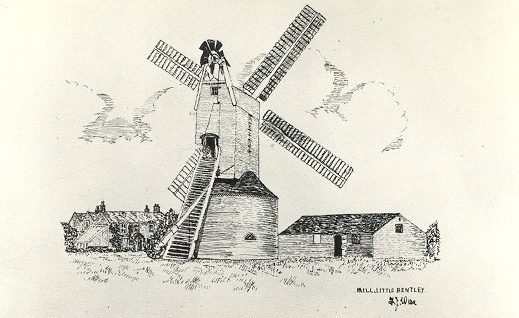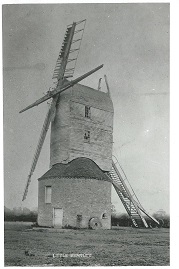Little Bentley Windmill
Little Bentley Windmill was a typical East Anglian Post Mill. It was located on the south side of Tendring Road during the 19th century and was demolished in 1905. Post mills were the only mills designed to move as a unit in the course of their everyday work. It had a three-storey roundhouse and there were three separate floors in the buck - meal, stone and bin. The buck was turned to face the wind automatically by a fan mounted over the rear of the roof: an unusual feature.

In the beginning of the 19th century, the Mill was owned by Robert Buttrum. A history of Essex windmills provides details of his complicated life:
 In January 1811, Robert Buttrum of Little Bentley offered through the columns of the Chelmsford Chronicle a reward to any who could name the person circulating rumours imputing to him unwillingness to settle his debts. These, he confidently asserted, did not exceed £100 and he had intended to ignore the slanderous attach, but finding ‘that it was industriously circulated with the evident intention of injuring my credit and reputation, upon further reflection I deemed it advisable to pursue the steps I have taken, as a means of repelling the malignant motives directed against me.’ So far as Buttrum’s reputation was concerned, the bubble must long since have been pricked in the sight of the primly conventional, for he contrived to run not only three pairs of millstones, a bakehouse and a modest land holding, but also a wife and mistress. In June 1824, when his health was in rapid decline, he made a will and dies three months later. By Elizabeth Brooks, formerly of Brightlingsea, he had two natural sons, Robert Brooks and Frederick William Buttrum Brooks. To the second son, Buttrum, he devised ‘All that my copyhold messuage, windmill, corn granaries, stable, barn, outhouses, yards, gardens…three parcels of copyhold land…called Tye Fields…holden in the manor of Little Bentley…for ever’, to be entered on Buttrum’s attainment of 21 years. Robert was to receive a substantial legacy in addition to real estate to equalise the inheritance; during Frederick’s minority, the miller’s ‘beloved wife’ Martha was to receive £25 per annum from rents and interest, and Elizabeth Brooks £30 annually; each to choose items of furniture as desired, and both to live in a specially built cottage, Martha in one part and Elizabeth and her offspring in the other. Elizabeth was charged with the care of Martha, then ‘very weak in body and mind’, and, ironically, was to forgo her income of £30 if she married. According to a sale notice relating to the windmill in 1824, it had undergone complete repair, winded itself, and was working three pairs of stones, using patent sails. Frederick William Buttrum Brooks, miller and farmer, was concerned with the business until he died in 1850. A chip off the old block, he made generous provision in his will for the wife of a local butcher ‘irrespective of her husband’s actions’, by arranging for the investment of £500 from the sale of the estate, she to draw the interest.
In January 1811, Robert Buttrum of Little Bentley offered through the columns of the Chelmsford Chronicle a reward to any who could name the person circulating rumours imputing to him unwillingness to settle his debts. These, he confidently asserted, did not exceed £100 and he had intended to ignore the slanderous attach, but finding ‘that it was industriously circulated with the evident intention of injuring my credit and reputation, upon further reflection I deemed it advisable to pursue the steps I have taken, as a means of repelling the malignant motives directed against me.’ So far as Buttrum’s reputation was concerned, the bubble must long since have been pricked in the sight of the primly conventional, for he contrived to run not only three pairs of millstones, a bakehouse and a modest land holding, but also a wife and mistress. In June 1824, when his health was in rapid decline, he made a will and dies three months later. By Elizabeth Brooks, formerly of Brightlingsea, he had two natural sons, Robert Brooks and Frederick William Buttrum Brooks. To the second son, Buttrum, he devised ‘All that my copyhold messuage, windmill, corn granaries, stable, barn, outhouses, yards, gardens…three parcels of copyhold land…called Tye Fields…holden in the manor of Little Bentley…for ever’, to be entered on Buttrum’s attainment of 21 years. Robert was to receive a substantial legacy in addition to real estate to equalise the inheritance; during Frederick’s minority, the miller’s ‘beloved wife’ Martha was to receive £25 per annum from rents and interest, and Elizabeth Brooks £30 annually; each to choose items of furniture as desired, and both to live in a specially built cottage, Martha in one part and Elizabeth and her offspring in the other. Elizabeth was charged with the care of Martha, then ‘very weak in body and mind’, and, ironically, was to forgo her income of £30 if she married. According to a sale notice relating to the windmill in 1824, it had undergone complete repair, winded itself, and was working three pairs of stones, using patent sails. Frederick William Buttrum Brooks, miller and farmer, was concerned with the business until he died in 1850. A chip off the old block, he made generous provision in his will for the wife of a local butcher ‘irrespective of her husband’s actions’, by arranging for the investment of £500 from the sale of the estate, she to draw the interest.
***** Patricia Spray from New Zealand has written in to correct some of the claims made in the windmills book which is quoted above...
I can vouch for the correctness of the information beginning "So far as Buttrum's reputation was concerned...." there's a digit missing from the date at the beginning of the paragraph and an 'e' missing off the end of 'car' but those are minor errors.
The part that is most definitely incorrect is the last sentence beginning "A chip off the old block" etc. It seems to imply that Frederick William Buttrum Brooks had some sort of an affair going on with the local butcher's wife. Not so. The local butcher's wife was indeed his own mother, Elizabeth. Elizabeth Brooks was very young when she was with Robert Buttrum. I should imagine, but have no proof, that his affair with Elizabeth was a business arrangement. He had a sickly wife, who was unable to bear him children. He badly needed offspring and Elizabeth was a young healthy girl. She was only 20 years old when her first son was born. Robert Buttrum was in his mid forties. Of course, as I said, I have no proof of this, but it does seem likely.
However, I am sure that the last sentence is incorrect. Robert Butrum died in September 1824. Elizabeth was then only 23 years old. In approximately 1834 she married the local butcher, Carrington Cooper, and it was she that Frederick William Buttrum Brooks "made generous provision in his will for" . Elizabeth went on to have two more children, William and Carrington.
In the Census of 1831, the Mill House was the residence of the Mayhew family who had one son and two daughters. Mark Mayhew and his son ran the milling business.
After this, Frederick Brooks himself became the corn miller until he died in 1850
In 1870 Robert Brooks moved to Little Bentley from Ramsey where he had owned and worked the mill for 28 years. His son, Robert Brooks Jnr., took over the running of the Ramsey Mill for a few years and then leased it to his younger brother John. He succeeded his father at Little Bentley in 1878. By 1882, he was listed under liquidations, and twelve years later a successor, Benjamin Richardson, suffered a similar fate. The difficulties of keeping the mill as a going concern seems to have led to its remaining idle thereafter until its 1905 demolition.
